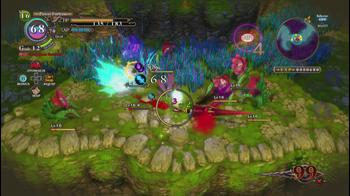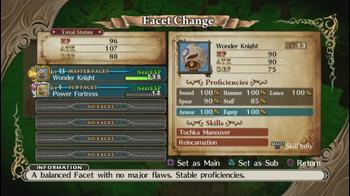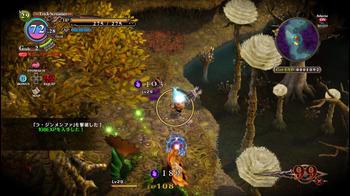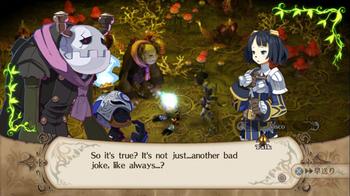
The Witch and the Hundred Knight Review
The Witch and the Hundred Knight is the very definition of a mixed bag. On the one hand, you have a decent combat system with plenty of customization layered in with systems to keep things interesting. On the other, you have a train wreck of a story that doesn't know what it wants to be and would rather make you feel extremely uncomfortable than explain itself.
Metallia is a young and extremely powerful witch who has been forced to isolate herself in the swamp that she was raised in, having been forced into this predicament by the Forest Witch. In order to help her obtain the goal of defeating the Forest Witch and spreading her swamp throughout the land and thus her domain, she calls upon a small but powerful Familiar called the Hundred Knight. Players will take control of this being, and are tasked to locate monuments known as Pillars that have the noxious swamp mud trapped within.
The combo-based Combat system is pretty straightforward. The Hundred Knight has an assortment of different weapons at his disposal - sword, spear, lance, staff, and hammer, with each either carrying a Slash or Blunt property that affect the kind of damage one can inflict based on the enemy being struck. These tools can also carry different status effects, such as poison or a higher chance of staggering the opponent. The Hundred Knight can equip up to five weapons at a time that can be chained together to cause even more damage.
Throughout the game, players will have the opportunity to use Tochkas. Tochkas are special skills that are obtained either from chests or at certain moments in the story, and include abilities such as laying down a timed bomb, setting a trap to capture and kill enemies who are low in health, summoning a mini soldier to fight alongside you, and more. R1 lets players lock on to a target, letting them orbit whatever they are looking at, as well as check out their current moral state which is represented by a triangle - they can either be in love, angry, or fearful. Once they are angry, their attack and defense doubles, so players must be extra cautious if they try and get too close, otherwise the enemy may wipe Hundred Knight in a single hit.
Facets also play a part in gameplay. Unlocked over the course of the game much like Tochkas, it acts like sort of a job system where the Main facet is most prominent, while players can equip two Sub-facets, allowing them to take advantage of their passive abilities like a slowly-draining Stamina bar or higher defense. It's a neat feature that is welcome in this genre that usually doesn't go much farther than a single class.
Every action taken in combat and elsewhere comes at the expense of a gauge called the GigaCals. Every time the Hundred Knight takes damage or simply moves about the map, this meter drops down from its starting point of 100.0%. The only way to replenish this meter is by either using an item that affects it or by returning to base or the world map through a Pillar. Once the bar hits zero, the Hundred Knight’s attack and defense drops by 30% and the health bar begins to drain rather quickly.
Due to how difficult the game can be as things go on, it isn’t unusual to take multiple trips out of the map to quickly regroup and come back, since even dying during a fight can also wipe out about 20% of the gauge. It can get rather frustrating trying to enjoy what the game has to offer when I was constantly worrying about the status of this bar, especially when it doesn’t stop draining even when control is taken away from the player when Hundred Knight is opening a chest or activating a switch.
Overall, the combat was decent. I had a good time trying to find better and stronger weapons and armor to equip, and it was satisfying being able to one-hit kill enemies who not long ago was causing a real headache. There are several systems in place to keep a person somewhat hooked to what was going on.
The game also includes questionable design decisions. For example, as mentioned above, Pillars are scattered all across almost every map that the player finds themselves in. Once these Pillars bloom, aside from being able to allocate Grade points, they also have the option of either warping back to home base or return to the map. However, some maps also have multiple ways to just walk yourself out to the world map normally without the use of the Pillar. Unfortunately, what they don’t tell you is that you forfeit all of your earned XP and items in your stomach if you decide to do this, and does it without any kind of warning.
I don’t understand why the developers would do this, considering they offer up these different exits, and getting to them can be just as difficult as finding one of these Pillars at times. Not to mention, there exists a map where you have no choice but to hurry through, avoiding all of the enemies along the way, when no real urgency existed beforehand as far as the plot was concerned.
Towards the end of the game, the plot pretty much collapses upon itself, and everything stops making sense. New characters are introduced in the final chapter that is impossible to care about because they didn’t spend any time developing them, and for the rest, I simply tried to work out what exactly their motivation was to bring about their sudden change in behavior. It was as if the writers took the time to just make everyone out to be big jerks and leave things at that. Even the dialogue gets confusing, with characters drifting from one explanation for their actions to another, either side not displaying any rhyme or reason.
Map design can be hit or miss at times. While some maps are large and expansive with an atmosphere that is laid on stick, others are boring labyrinths with few monster encounters in between. When the perspective isn’t top-down but instead at a quarter angle, there is almost always something obstructing the view of the camera and thus the enemies themselves. The right analog stick lets you move the camera around to a more appropriate view, but it moves at such a slow click that I usually didn’t even bother, especially since I had my hands full with an encounter. Some maps are just plain boring and a chore just to get through. I will say that some of the locations are well done and a few contain puzzles that I could only blame myself for not figuring out.
Here, these bad moments can sometimes be thrust upon the player, and even when some of the characters in the story wind up dying, I found myself not really caring. I will be the first to admit that I can be an easy target when it comes to these types of things, but more times than not I felt like I was trying to search within myself to find out if this was something worth getting sentimental about, especially when everyone in the game are, as mentioned, jerks.
As I talked about before, the role of the Hundred Knight is to find these Pillars that can release swamp mud which helps Metallia to freely go further and further out from her base. If Metallia stays away from the swamp for too long, she slowly loses her magic and her health degenerates as a result. And then at some point she decides that this doesn’t matter and winds up voluntarily getting herself sick, refusing to return home for some ungodly reason (I think the plot had its hands wrapped around her neck). It completely destroyed any respect one had for her as a character, which is clearly not how to want your game’s story to go near its climax.
It doesn’t help matters when during an early plot point, something highly inappropriate happens between Metallia and another character that throws a whole wrench into our heroine as a person one would feel attached to. It took me hours to finally build up the tolerance to once again get her on my good side, when later on, they go back and explain the connection between these two people, and it just ended up making me like her even less as an individual.
This is surprising considering that we are talking about the same people who made Disgaea, a group who was arguably very successful in creating evil characters that you actually really cared about and didn’t want to see anything bad happen to them - even to the point of being shook up emotionally during some of the more dramatic moments. Here, even what some could call the characters meant to have the most appeal come away looking either like idiots or very naive.
What happens at the end of the game completely destroys everything that this story was hoping to achieve. To avoid any spoilers, Witch and the Hundred Knight contains multiple endings that obviously change based on the decisions you make and the actions you take earlier on. I happened to get the True Ending, which is really just going through like normal with logical choices. Let me just say that at the end, every single person in the game does not come out unscathed, and NOTHING is explained. I was left there feeling completely soured with what was happening, which didn’t help after the mess that was the final chapter. Many characters are left out to dry or written off off-screen, leaving a giant gaping hole where the plot used to be.
That isn’t to say that Witch and the Hundred Knight is a terrible game. If you go into this not caring too much about the story and its characters, the combat works well enough to keep you busy, and even if there is padding involved, the thie game takes about 30 hours to beat. Plus, there are ways of increasing the difficulty of the enemies to keep the challenge there. The graphics are good for a Nippon Ichi title, with character model detail looking nice and the environments, especially forests, thick with vegetation. The game also performs well, though there was some framerate stuttering going on and a hitch pretty much every time the GigaCal meter fell below 10%. The music from Tenpei Sato is also very nice to listen to, even if you’ll hear a lot of the same tracks played over and again. I just wish the story hadn’t gone into the toilet.



